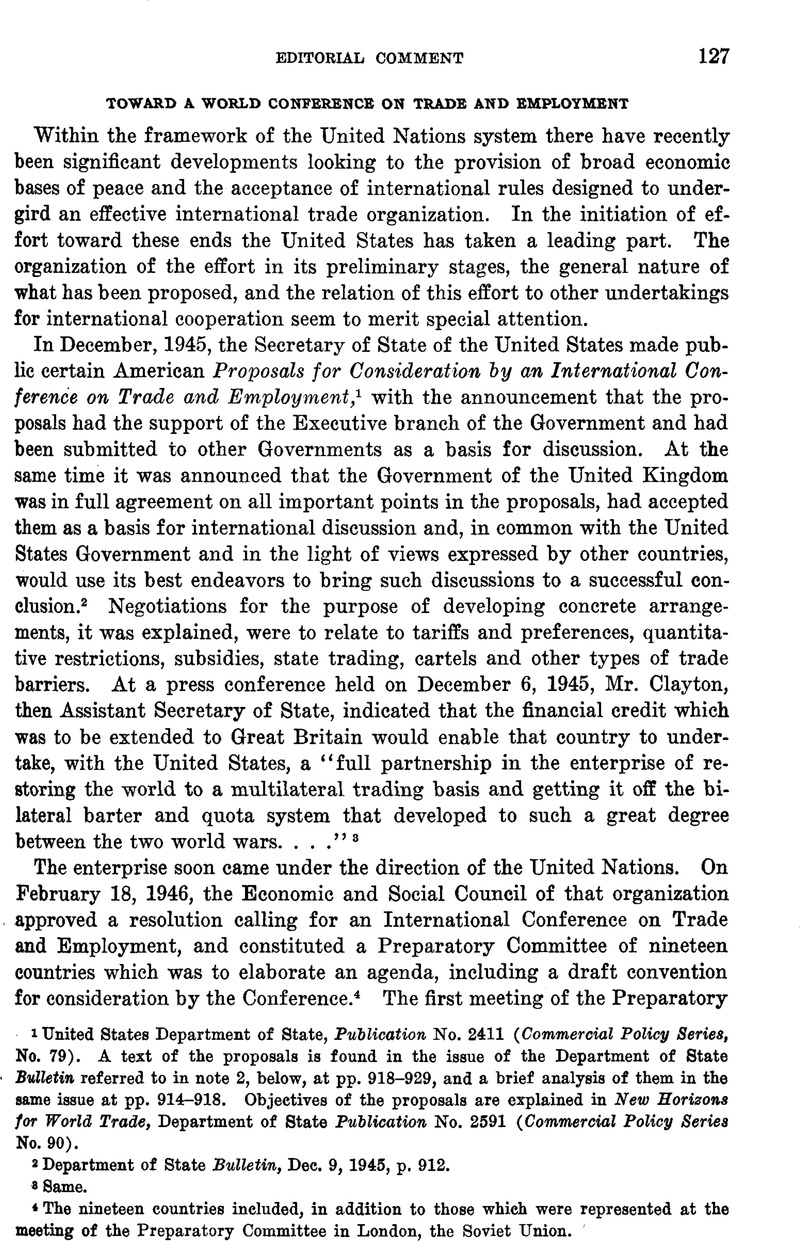No CrossRef data available.
Article contents
Toward a World Conference on Trade and Employment
Published online by Cambridge University Press: 20 April 2017
Abstract

- Type
- Editorial Comment
- Information
- Copyright
- Copyright © American Society of International Law 1947
References
1 United States Department of State, Publication No. 2411 (Commercial Policy Series, No. 79). A text of the proposals is found in the issue of the Department of State Bulletin referred to in note 2, below, at pp. 918-929, and a brief analysis of them in the same issue at pp. 914-918. Objectives of the proposals are explained in New Horizons for World Trade, Department of State Publication No. 2591 (Commercial Policy Series No. 90).
2 Department of State Bulletin, Dee. 9, 1945, p. 912.
3 Same.
4 The nineteen countries included, in addition to those which were represented at the meeting of the Preparatory Committee in London, the Soviet Union.
5 Department of State Publication No. 2598 (Commercial Policy Series No. 93).
6 Note 1, above.
7 The New York Times, Dec. 1, 1946, Sec. E, p. 4. The countries represented were Australia, Belgium, Brazil, Czechoslovakia, Luxemburg, Canada, Chile, China, Cuba, France, India, Lebanon, The Netherlands, New Zealand, Norway, Union of South Africa, the United Kingdom, and the United States.
8 The New York Times, Oct. 16, 1946, p. 12. The speaker also included in his remarks the following comments : “Hitherto it has been considered sufficient if each nation regulated its conduct in these matters in accordance with the bilateral treaties it has entered into. It was no one else’s concern as to what those treaties contained or how they would affect others, and beyond that it was accepted that each country could do as it liked with its own market.
“It was that accepted attitude to international trade which led us into the disastrous chaos of the interwar years.”
9 Remarks of Clair Wilcox, as reproduced in Department of State Bulletin, Oct. 27, 1946, pp. 759-760.
10 The New York Times, Oct. 17, 1946, p. 4. In an address before the American Chamber of Commerce in London while the conference was going on, the British Parliamentary Secretary of the Ministry of Fuel and Power drew attention to the fact that, in the original proposals of the United States thirteen pages were given to trade policy and two paragraphs to employment (same, Oct. 24, 1946, p. 6). It was later reported that there had been agreement on the subject of employment (same, Oct. 31, p. 9, Nov. 12, p. 8).
11 The New York Times, Oct. 18, 1946, p. 34; Nov. 27, 1946, p. 31.
12 Same, Nov. 27, 1946, p. 8 (remarks of M. Duret). The same speaker is reported to have advocated that weaker countries be allowed to discriminate and apply trade restrictions until they could compete.
13 Same, Nov. 24, 1946, pp. 1, 5. It was estimated that there was agreement on ninety per cent of the text of the charter (Michael L. Hoffman, in same, Dec. 1, 1946, p. 4E).
14 Same, Nov. 27, 1946, p. 8.
15 Same, Nov. 29, 1946, p. 5.
16 Department of State Bulletin, Nov. 17, 1946, p. 907. For public notice of the Department of State pursuant to legislation concerning trade agreements, see 11 Federal Register 13447. The list of products, to be considered for the possible granting of tariff concessions by the United States under the broadened authority given in the Act approved July 5,1945 (59 Statutes 411), is printed in Department of State Publication No. 2672 (Commercial Policy Series No. 96).
17 Department of State Bulletin, Nov. 17, 1946, p. 909.
18 See the statement of the Permanent Court of International Justice in its Publications, Series A/B, No. 46, p. 162.
19 Art. 31. By the final paragraph of this article the members would accept this rule as to any international obligations they may have which would prevent them from giving full effect to the following paragraphs of the charter :
1. No Member shall seek exclusive or preferential advantages for its trade in the territory of any non-Member which would result, directly or indirectly, in discrimination in that territory against the trade of any other Member.
2. No Member shall be a party to any agreement or other arrangement with any non-Member under which such non-Member shall be contractually entitled to any of the benefits under this Charter.
20 Art. 76. The parts of the Charter referred to in this connection are subparagraphs (e), (d), (e) and (k) of Article 32 (the general exceptions article in Chapter IV) and paragraph 2 of Article 49 (on exceptions to provisions relating to intergovernmental commodity agreements).
21 Address of Mr. Clayton before the National Foreign Trade Convention, Nov. 13, 1946: Department of State Bulletin, November 24, 1946, p. 953.




